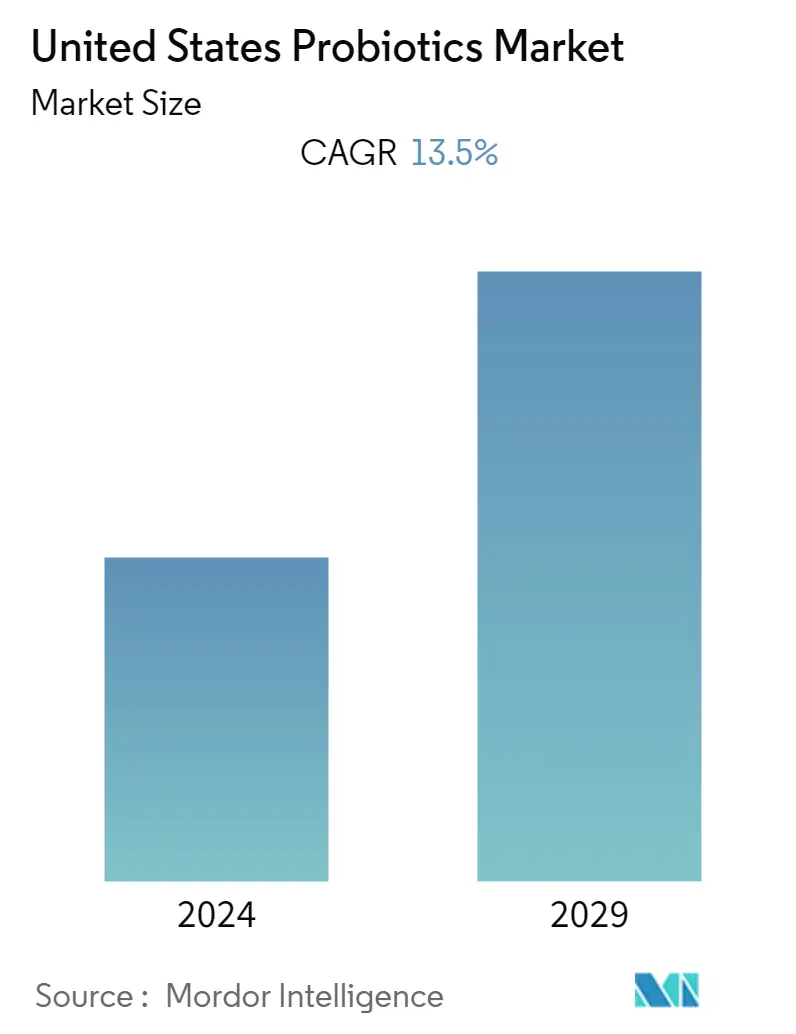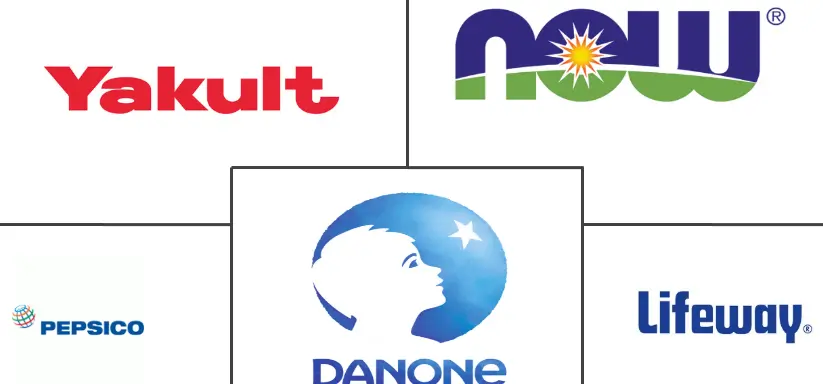Market Size of United States Probiotics Industry

| Study Period | 2019 - 2029 |
| Base Year For Estimation | 2023 |
| Forecast Data Period | 2024 - 2029 |
| Historical Data Period | 2019 - 2022 |
| CAGR | 13.50 % |
| Market Concentration | Low |
Major Players
*Disclaimer: Major Players sorted in no particular order |
US Probiotics Market Analysis
The United States probiotics market is projected to register a CAGR of 13.5% during the forecast period (2022-2027).
The COVID-19 pandemic has had a greater impact on the shift in consumption patterns of consumers as their health consciousness among them has increased. Consumers in the US started to avoid junk or processed foods and look for health-beneficial and nutritive foods and products. The sales of probiotic products in the US increased by 33% since the pandemic, as the consumers are inclined toward nutrient boosters to improve their immunity. Since then, the demand for probiotic products in the US has increased drastically. As all age groups are vulnerable to the virus, manufacturers are designing probiotic products that can have effective results for every individual.
Over the medium term, increasing health consciousness and the consumers' preference for nutritive foods are expected to drive the market. Probiotics are a driving force within the booming digestive health supplement category, and they are being consumed by people of all age groups. However, the major consumption is observed among the millennials, due to the growing awareness about health and wellness through multi-channel publicity, which has influenced their consumption pattern to a large extent.
The healthcare expenditure pattern in the country is rising with the growing geriatric population, advanced technology, better medical facilities, and a rise in the number of insured people. These factors are, in turn, driving the overall sale of probiotics in the country.However, high R&D costs for developing new probiotic strains, high initial investments, and high prices of the products are expected to slow down the markets growth.
US Probiotics Industry Segmentation
Probiotics are live microorganisms that provide health benefits when consumed, generally by improving or restoring gut health. The US probiotics market is segmented by type that includes probiotic food, probiotic drinks, dietary supplements, and animal feed. The probiotic food section is further divided into yogurt, bakery and breakfast cereals, baby food and infant formula, confectionery, and other products. The probiotic drinks segment is further classified into fruit-based probiotic drinks, dairy-based probiotic drinks, and other probiotic drinks. Based on the distribution channel, the market is divided into supermarkets/hypermarkets, pharmacies and drug stores, convenience stores, online channels, and other distribution channels. The report offers market size and forecasts in value (USD million) for the above segments.
| By Type | |||||||
| |||||||
| |||||||
| Dietary Supplements | |||||||
| Others |
| By Distribution Channel | |
| Supermarket/Hypermarket | |
| Pharmacies and Drug Stores | |
| Convenience Stores | |
| Online Channels | |
| Other Distribution Channels |
United States Probiotics Market Size Summary
The US probiotics market is experiencing significant growth, driven by an increased consumer focus on health and wellness, particularly following the COVID-19 pandemic. This shift has led to a surge in demand for probiotic products, as consumers seek foods that boost immunity and overall health. Probiotics are becoming a key component of the digestive health supplement category, with a notable consumption trend among millennials who are influenced by heightened awareness through various media channels. The market is further supported by rising healthcare expenditures, advancements in medical technology, and a growing geriatric population, all of which contribute to the increased sales of probiotics. However, challenges such as high research and development costs, initial investments, and product pricing may impede market growth.
The competitive landscape of the US probiotics market is characterized by a fragmented structure with numerous players vying for market share. Key manufacturers are focusing on strategic initiatives such as product expansion, new launches, and partnerships to enhance their market presence. The market is witnessing a trend towards premium positioning of probiotic products in supermarkets and hypermarkets, where products are increasingly labeled with health benefits related to probiotics. The introduction of dairy-free probiotic yogurts and innovative products like drinkable probiotic yogurts reflects the market's adaptability to consumer preferences, including the growing trend of veganism. Major players such as Danone, PepsiCo, and Lifeway Foods Inc. are actively engaging in product development and acquisitions to cater to the evolving consumer demands and to maintain a competitive edge.
United States Probiotics Market Size - Table of Contents
-
1. MARKET DYNAMICS
-
1.1 Market Drivers
-
1.2 Market Restraints
-
1.3 Porter's Five Forces Analysis
-
1.3.1 Threat of New Entrants
-
1.3.2 Bargaining Power of Buyers/Consumers
-
1.3.3 Bargaining Power of Suppliers
-
1.3.4 Threat of Substitute Products
-
1.3.5 Intensity of Competitive Rivalry
-
-
-
2. MARKET SEGMENTATION
-
2.1 By Type
-
2.1.1 Probiotic Food
-
2.1.1.1 Yogurt
-
2.1.1.2 Bakery and Breakfast Cereals
-
2.1.1.3 Baby Food and Infant Formula
-
2.1.1.4 Confectionery
-
2.1.1.5 Other Types
-
-
2.1.2 Probiotic Drinks
-
2.1.2.1 Fruit-based Probiotic Drinks
-
2.1.2.2 Dairy-based Probiotic Drinks
-
2.1.2.3 Other Probiotic Drinks
-
-
2.1.3 Dietary Supplements
-
2.1.4 Others
-
-
2.2 By Distribution Channel
-
2.2.1 Supermarket/Hypermarket
-
2.2.2 Pharmacies and Drug Stores
-
2.2.3 Convenience Stores
-
2.2.4 Online Channels
-
2.2.5 Other Distribution Channels
-
-
United States Probiotics Market Size FAQs
What is the current United States Probiotics Market size?
The United States Probiotics Market is projected to register a CAGR of 13.5% during the forecast period (2024-2029)
Who are the key players in United States Probiotics Market?
Danone, PepsiCo, Now Foods, Yakult Honsha Co. Ltd and Lifeway Foods Inc. are the major companies operating in the United States Probiotics Market.

